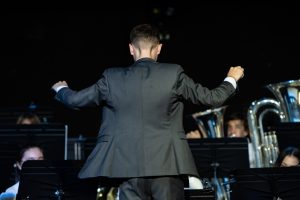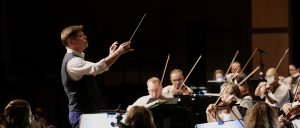View from the Podium
It's more than just waving your arms

A few decades ago, I put together a concert featuring music I’d arranged for a small orchestra, choir and soloists. I was to be the conductor. On the evening of the performance, I stepped onto center stage, faced the ensemble, opened my music score and, to my bewilderment, found a note. It was titled “Directions for the Conductor.”
I opened it and read “Wave your arms until the music stops, then turn around and bow.” I looked up to see all eyes on me, accompanied by smiles. I smiled back, gave a discreet thumbs up, and we began an evening of music. Whatever success there was that evening resulted from the talent and hard work of the musicians. All I did was … wave my arms.
That experience raises a question: Does an orchestra really need a conductor? The short answer is a good conductor is an essential member of the group. And the longer answer is to achieve the performance level audiences have come to expect, a conductor must bring at least five qualities to the podium to add value.
The first quality is leadership. It’s quite literally the hands of the conductor that keep each player in sync with the rest of the ensemble. And leadership happens when trust and respect between the conductor and the orchestra are established. The tempo of the music, the volume of the instruments and the expression of the musical phrases need to be conveyed and understood from the first rehearsal.
Great leadership sometimes demands actions beyond the podium. Years ago, I witnessed amazing leadership at the Santa Barbara Symphony Orchestra. During a performance of an avant-garde work — one that might challenge listeners — there was a sudden, but mild, agitation from the front rows. Audience members began to walk out of the theater. The conductor initially turned to glare at the rudeness but then saw smoke pouring from below the stage.

Without missing a beat, the conductor stopped the music, directed orchestra members to exit the stage, then turned and silently directed the audience to the exits. The conductor was the last to leave, baton in hand. The next day’s front page of the local newspaper complimented the conductor on his quick action, acknowledging how dangerous a fire in a crowded theater can be. The joke backstage was the conductor got a standing ovation for saving lives.
The next and most obvious function of the conductor is as the beat-keeper. That job is to set the tempo of the music and keep time for the orchestra. It’s the conductor’s baton in the right hand that keeps the beat, and only the conductor who determines the tempo.
The third function is to keep the various sections of the orchestra together and to bring them in at the right time. The conductor cues each section of the orchestra, again using only a gesture. There can be as many as 20 sections and up to 100 performers for the conductor to manage. This alone demands complete knowledge of each section and when they should enter and cease. The conductor also adjusts the volume and expressiveness of each section as needed, using the left hand.
A few years ago, an experiment took place with a studio orchestra, the type that records soundtracks for movies and TV. They played a symphonic movement with a conductor and had no apparent problems. Then the movement was repeated without a conductor. The result was clearly ragged sounding, as the instrumental sections struggled to play their parts in unison.
The fourth duty is being a teacher and communicator. Creating memorable music is worked out at rehearsals, when conductors provide the musicians with suggestions of how their section can best play its part. Players sitting inside the orchestra can’t hear what the audience will hear. In all ways, the conductor represents both what the composer intended and the audience expects.
 Finally, for music to be inspiring to the listener, there must be a clear understanding of the appropriate musical expression. Michael Hall, Music Director and Conductor of the Kennett Symphony, shared with me his background for achieving excellence in the art of conducting.
Finally, for music to be inspiring to the listener, there must be a clear understanding of the appropriate musical expression. Michael Hall, Music Director and Conductor of the Kennett Symphony, shared with me his background for achieving excellence in the art of conducting.
“So much can be learned by watching and listening to other great conductors,” Hall said. “It takes years to develop the emotional attentiveness needed to fully understand the complexities of musical expression and, at the same time, there must be an awareness of the audience expectations. When we achieve that, we’re able to keep the audience delighted — even inspired — throughout an evening of music.”
To bring out the best in an orchestra, teamwork is the key. And all teams need a leader, sometimes with baton in hand, to meet every challenge and opportunity.
For an entertaining YouTube video, see Rainer Hersch’s “Does an orchestra need a conductor?”
Malcolm Johnstone is the Community Engagement Officer for Arts, Culture and Historic Preservation for the Cultural Alliance of Chester County, an initiative of the Chester County Community Foundation. A graduate of the San Francisco Conservatory of Music, he trained as a classical musician.
